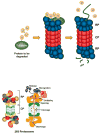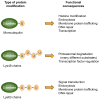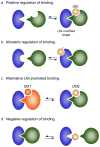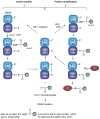Origin and function of ubiquitin-like proteins
- PMID: 19325621
- PMCID: PMC2819001
- DOI: 10.1038/nature07958
Origin and function of ubiquitin-like proteins
Abstract
Eukaryotic proteins can be modified through attachment to various small molecules and proteins. One such modification is conjugation to ubiquitin and ubiquitin-like proteins (UBLs), which controls an enormous range of physiological processes. Bound UBLs mainly regulate the interactions of proteins with other macromolecules, for example binding to the proteasome or recruitment to chromatin. The various UBL systems use related enzymes to attach specific UBLs to proteins (or other molecules), and most of these attachments are transient. There is increasing evidence suggesting that such UBL-protein modification evolved from prokaryotic sulphurtransferase systems or related enzymes. Moreover, proteins similar to UBL-conjugating enzymes and UBL-deconjugating enzymes seem to have already been widespread at the time of the last common ancestor of eukaryotes, suggesting that UBL-protein conjugation did not first evolve in eukaryotes.
Figures





References
-
- Hochstrasser M. Evolution and function of ubiquitin-like protein-conjugation systems. Nat Cell Biol. 2000;2:E153–E157. - PubMed
-
- Pickart CM. Mechanisms Underlying Ubiquitination. Annu Rev Biochem. 2001;70:503–533. - PubMed
-
- Kerscher O, Felberbaum R, Hochstrasser M. Modification of proteins by ubiquitin and ubiquitin-like proteins. Annu Rev Cell Dev Biol. 2006;22:159–180. - PubMed
-
- Mukhopadhyay D, Riezman H. Proteasome-independent functions of ubiquitin in endocytosis and signaling. Science. 2007;315:201–5. - PubMed
Publication types
MeSH terms
Substances
Grants and funding
LinkOut - more resources
Full Text Sources
Other Literature Sources

